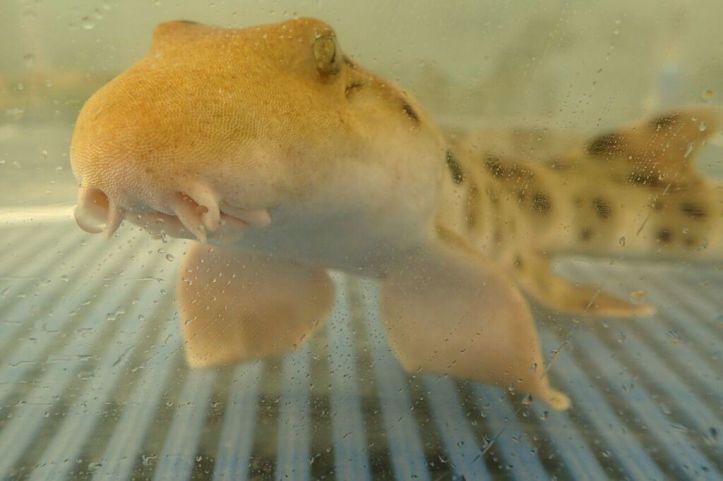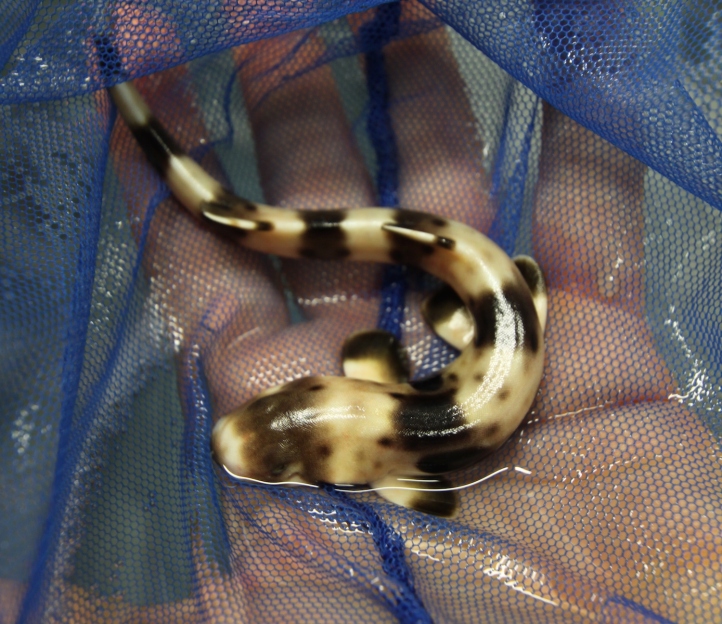It’s nighttime on the Great Barrier Reef, and as the tide slips out to sea it uncovers a much tougher environment. Chunks of coral are exposed and only small pools of shallow water remain where there is little oxygen available. Hardly the place you expect to find a shark.
But! This is not your ordinary shark (it’s odd organisms for gosh sakes). No, this is an epaulette shark (Hemiscyllium ocellatum). A wriggly, wormy, wonder shark whose amazing adaptations to it’s complex environment include an incredible tolerance to low oxygen and high CO2 levels, PLUS, the ability to walk across the reef! Walk!
So, it’s walking sharks and crucian carp on the blog today (more on crucian carp later, for now just accept the rhyme) as we explore the awesome adaptations of the epaulette shark. The first shark to have come anywhere near, rivaling my fascination for the goblin shark (and may just be walking it’s way to first place).

Adaptation 1: Walk like an Egyp-aulette shark
For most fish, getting stuck in the reef at low tide would equal: confinement to a tiny pool of water, or worse, left above water unable to breath. And yet, the epaulette shark has found a way around this that allows it not just to survive these harsh conditions, but thrive in them too.
They can walk, outside of their ocean home, across the exposed coral.
Achieved by a swishing of their bodies and ‘steps’ made with their paired fins, it produces a gait that while, not fast, effectively transports them between pools to continue hunting at low tide.
But how can they leave the water to walk – or even hunt in these shallow pools of water, where they can’t breathe or little oxygen exists?
Adaptation 2: Who needs oxygen anyway?
Brains. That’s who. Without enough oxygen most vertebrates die within a few minutes because their blood can no longer carry enough oxygen to the brain to keep it functioning. So it’s remarkable, that studies have found the epaulette shark can go for three and a half hours with extremely low levels of it.
This ability to survive very low levels of oxygen, or hypoxic conditions, is highly unusual in marine species because they’re seldom encountered, and usually easily avoidable (just swim away into more ocean, right?). Smaller freshwater environments are much more prone to a lack of oxygen because they can dry up, or become stagnant.
In fact, some of the most well studied animals that can survive hypoxic conditions include freshwater species such as crucian carp and North American freshwater turtles – which can survive up to a crazy two days without the stuff. However, to cope with this lack of oxygen, these animals enter a hibernation-like state and are no longer able to move voluntarily. Not so for the epaulette shark. Amazingly, they can still move about!

Adaptation 3: Future fighters
Hardier still, epaulette sharks are also tolerant to high levels of CO2. So much so, new research has shown that even at the embryo stage, epaulette sharks will be able to cope with the increased CO2 levels predicted at the end of this century. An increase from 400 μatm, to approximately 945 μatm. While this is positive news that these sharks may be able to survive an increase in ocean acidification in the future, it’s important to note that whilst the development phase studied by the researchers was unaffected by CO2, other stages could be still be hindered by higher levels.
All these incredible abilities; the epaulette sharks’ weird walk, tolerance to low oxygen levels and high levels of CO2 , are effective adaptations to life in their complex coral environment. The constant exposure to low tides on the reef has helped produce this poky little shark, who really steps it up when it comes to being tough. And when I consider my day: two car trips and five hours of sitting down listening to honours talks at uni, I can’t help but wonder – have I been out-walked by a shark today?
I’m totally cool with it if I have.
Reblogged this on Overlooked Nature and commented:
Sorry I’ve been neglecting my blog lately. Life is, and will continue to be for the next couple months, very busy. In lieu of actually writing a post, here’s a fascinating look at the walking shark from the excellent blog Odd Organisms.
LikeLike
[…] check out this neat BLOG POST about epaulette […]
LikeLike
[…] sharks don’t just swim, they can walk! When the tide rolls out, stranding them on the coral flats they frequent, they use their fins […]
LikeLike